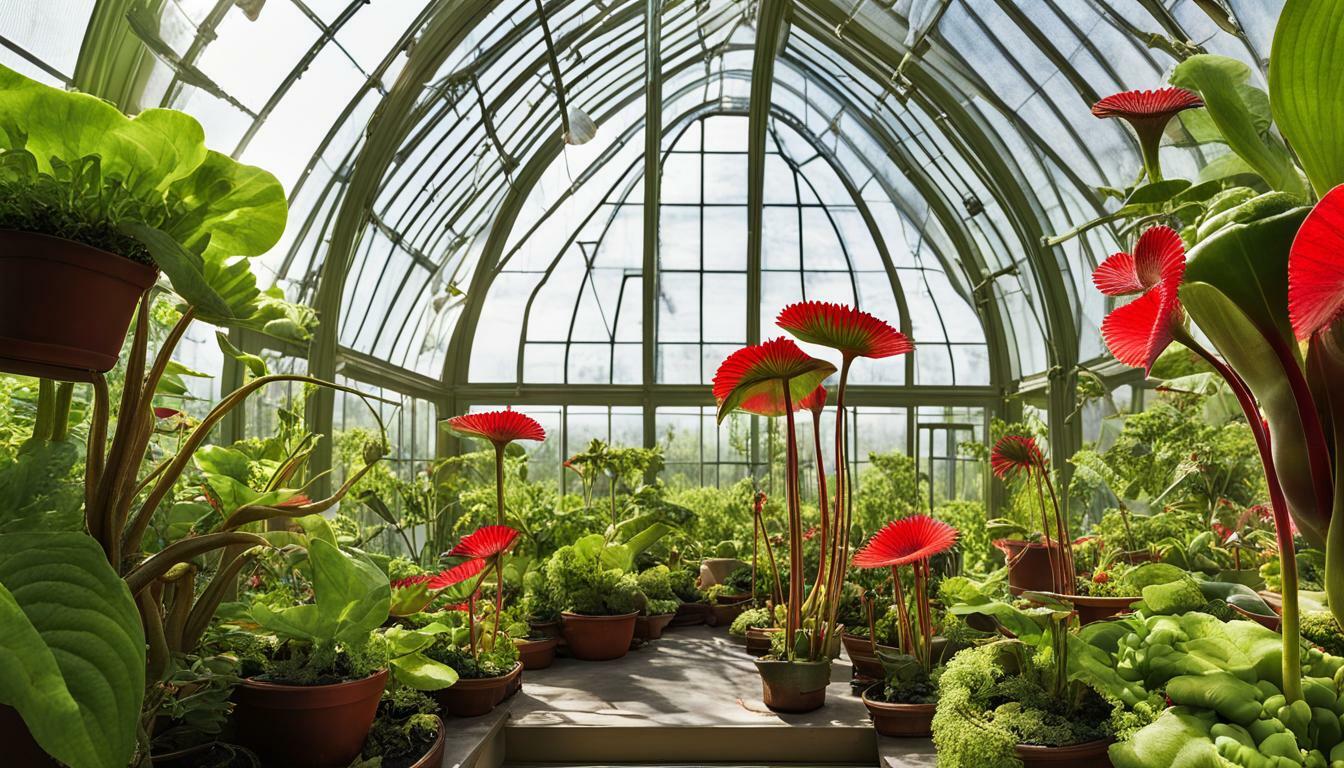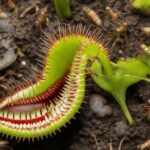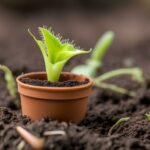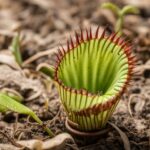If you’re a fan of carnivorous plants and are wondering if Venus Flytraps can be grown in a greenhouse, the answer is a definite yes! Greenhouse cultivation offers numerous benefits for this unique plant, as it allows for controlled conditions that replicate their natural environment. Growing Venus Flytraps in a greenhouse not only provides protection against pests but also extends the growing season, allowing you to enjoy their captivating beauty all year round.
In this section, we’ll explore the possibility of growing Venus Flytraps in a greenhouse and guide you through the specific care requirements necessary for successfully cultivating these carnivorous plants in a controlled environment. Read on to discover how easy it is to create the perfect Venus Flytrap habitat in your greenhouse.
Key Takeaways:
- Yes, Venus Flytraps can be grown in a greenhouse.
- Greenhouse cultivation provides numerous benefits for Venus Flytraps.
- Proper care is necessary for successful Venus Flytrap cultivation in a greenhouse.
Greenhouse Cultivation of Venus Flytraps
When it comes to growing Venus Flytraps, a greenhouse can be an ideal environment. Controlled conditions allow you to create the perfect growing environment for these unique and fascinating carnivorous plants. Whether you’re an experienced greenhouse gardener or just starting, here are some considerations to make when growing Venus Flytraps in your greenhouse.
Benefits of Greenhouse Cultivation
One of the key benefits of greenhouse cultivation is the ability to control the environment. Venus Flytraps require specific conditions to thrive, including warm temperatures, high humidity, and bright light. A greenhouse can provide all of these conditions, allowing you to grow healthy and thriving plants.
Another advantage of greenhouse cultivation is protection from pests. Venus Flytraps are susceptible to a range of pests, including fungus gnats and spider mites. In a greenhouse, you can control the environment and prevent these pests from damaging your plants.
Finally, greenhouse cultivation can extend the growing season for Venus Flytraps. In their natural habitat, Venus Flytraps grow during the warmer months and enter a period of dormancy during the winter. In a greenhouse, however, you can control the growing conditions and keep your plants active year-round.
Care Requirements for Greenhouse Venus Flytraps
While growing Venus Flytraps in a greenhouse can be advantageous, it’s important to remember that these plants still have specific care requirements. Here are a few things to keep in mind:
- Temperature: Venus Flytraps prefer temperatures between 70-85°F during the day and 40-60°F at night.
- Humidity: These plants require high humidity levels, ideally around 60-80%. This can be achieved by misting the plants regularly or using a humidifier.
- Light: Venus Flytraps need bright, indirect light. You can achieve this by placing them near a south-facing window or using artificial grow lights.
- Soil: Venus Flytraps require well-draining soil that is low in nutrients, such as a mix of peat moss and perlite.
- Water: These plants prefer to be kept moist, but not waterlogged. Water them regularly with distilled water or rainwater.
By meeting these care requirements, you can ensure that your Venus Flytraps thrive in your greenhouse environment. In the next section, we’ll explore the steps you can take to create the ideal growing conditions for your plants.
Creating the Ideal Greenhouse Conditions for Venus Flytraps
When it comes to growing Venus Flytraps in a greenhouse, creating the ideal conditions is crucial. These unique plants have specific temperature, humidity, and lighting requirements that must be met for optimal growth and health.
To ensure your Venus Flytraps thrive in your greenhouse, here are some key factors to consider:
Temperature
Venus Flytraps prefer moderate temperatures, with a range between 70-85°F during the day and a slight drop to 60-70°F at night. Keep in mind that high temperatures can cause the soil to dry out quickly, so you’ll need to monitor the soil moisture and adjust accordingly.
Humidity
These plants require high humidity levels, between 50-60%. To maintain these levels in your greenhouse, you can use a humidifier or set up a tray of water near your Venus Flytraps, being careful not to let the pots sit directly in the water.
Lighting
Venus Flytraps need bright, indirect light for at least 12 hours a day. Position your plants near a south-facing window or use fluorescent grow lights to supplement natural light.
Airflow
Airflow is important for preventing fungal growth and maintaining optimal humidity levels. You can achieve proper airflow by using fans or opening vents in your greenhouse.
Soil
Venus Flytraps require well-draining soil that is low in nutrients. Use a mixture of peat moss, sand, and perlite for the best results. Avoid using regular potting soil or fertilizers, which can harm the plants.
By creating the ideal conditions in your greenhouse, your Venus Flytraps will be able to thrive and grow to their full potential. Keep these care tips in mind and enjoy watching your unique and fascinating carnivorous plants flourish.
How to Grow Venus Flytraps in a Greenhouse
If you’re considering growing Venus Flytraps in your greenhouse, you’ll need to know the proper care techniques to ensure their successful growth and development. Here are the steps you should follow:
- Choose the right soil mix: Venus Flytraps require a unique soil mix that is free of nutrients and minerals commonly found in regular potting soil. A mix of peat moss and perlite with a pH level between 4.5 and 5.5 is ideal.
- Provide adequate light: Venus Flytraps require a lot of light to grow properly. Place them in a sunny location in your greenhouse, or use grow lights if natural light is limited.
- Maintain proper temperature and humidity: Venus Flytraps prefer a temperature range between 70-80°F during the day and 50-60°F at night. They also require high humidity levels of around 70-80%. Install a humidifier in your greenhouse if necessary.
- Water carefully: Venus Flytraps are sensitive to overwatering and require a specific watering technique. Fill a tray with distilled or rainwater and set your plants in it so that the soil can absorb the water from the bottom up. Refill the tray when the water level drops below an inch.
- Fertilize sparingly: Venus Flytraps obtain their nutrients from the insects they catch, so they require little fertilization. Only feed them live bugs such as fruit flies or crickets, once a month or less.
- Maintain good air circulation: Venus Flytraps require good air circulation to prevent fungal diseases and pest infestations. You can use fans or open your greenhouse vents to achieve this.
- Prune carefully: Venus Flytraps require pruning to remove dead leaves and traps and promote new growth. Use clean scissors and only remove the brown or black part of the leaf or trap, leaving the green part untouched.
- Monitor for pests: Venus Flytraps are susceptible to insect infestations such as aphids or spider mites. Monitor your plants regularly and use appropriate organic methods such as neem oil to control pests if necessary.
Following these steps will ensure the healthy growth and development of your Venus Flytraps in your greenhouse. Remember to observe them regularly, enjoy their unique beauty, and marvel at their insect-catching abilities.
Advantages of Growing Venus Flytraps in a Greenhouse
If you’re considering adding Venus Flytraps to your greenhouse collection, you might be wondering what advantages this unique plant can bring. Here are some benefits of growing Venus Flytraps in a greenhouse:
- Controlled environment: Venus Flytraps require specific conditions to thrive, and a greenhouse allows you to regulate temperature, humidity, and light levels to ensure optimal growth.
- Extended growing season: With a greenhouse, you can grow Venus Flytraps year-round, regardless of your local climate.
- Protection against pests: Venus Flytraps are prone to pests like spider mites and aphids, but a greenhouse can help shield your plants from these and other insects.
- Showcase their unique beauty: Venus Flytraps are fascinating plants that capture insects with their specialized leaves. In a greenhouse, you can create an ideal environment to showcase their beauty and watch them at work.
Overall, greenhouse cultivation offers numerous benefits for Venus Flytrap growers, providing a safe and controlled environment that maximizes their growth potential.
Tips for Growing Venus Flytraps in a Greenhouse
Growing Venus Flytraps in a greenhouse can be a rewarding experience, but it requires a bit of knowledge and effort to ensure their proper growth and health. Here are some tips to help you successfully grow these fascinating carnivorous plants in your greenhouse:
- Choose the right potting mix: Venus Flytraps require a nutrient-poor soil mix that is well-draining. A mix of peat moss and perlite or sand works well.
- Provide ample light: Venus Flytraps require plenty of bright, direct light to grow and thrive. Artificial lighting can also be used to supplement natural light.
- Keep the humidity high: Venus Flytraps require high humidity levels to grow well. Using a humidifier or misting the plants regularly can help maintain the necessary humidity levels.
- Water properly: Venus Flytraps require water that is low in minerals and nutrients. Use distilled or rainwater and make sure the soil is moist but not too wet. Avoid letting the plants sit in standing water.
- Fertilize sparingly: Venus Flytraps do not require fertilizer, as they obtain their nutrients from the insects they catch. Applying fertilizer can actually harm the plants and should be avoided.
- Control pests: Since Venus Flytraps are susceptible to pests, it’s important to monitor them regularly and take steps to control any infestations. Non-toxic insecticidal soap or sticky traps can be effective measures.
By following these tips and providing the proper care and environment for your Venus Flytraps, you can enjoy the beauty and insect-catching abilities of these unique plants in your greenhouse.
Maintenance and Care for Greenhouse Venus Flytraps
Now that you’ve successfully grown your Venus Flytraps in a greenhouse, it’s important to maintain and care for them properly to ensure their longevity. Here are some tips to help you keep your plants healthy:
Watering
Venus Flytraps require consistently moist soil, but do not overwater them. It’s important to use distilled or rainwater, as tap water can contain minerals that can harm the plant. Water your plants when the soil starts to dry out, and make sure the water tray underneath the pot is always filled.
Feeding
Venus Flytraps obtain most of their nutrients from insects, so there’s no need to fertilize them. Instead, feed them small insects such as fruit flies or gnats, or even small pieces of raw meat. Do not feed them any processed or cooked food, as it can harm the plant.
Pruning
If your Venus Flytrap produces flower stalks, it’s best to cut them off to allow the plant to conserve energy for growing more leaves and traps. Remove any dead or dying leaves as well as any traps that have turned black or brown, as these are no longer functional and can attract pests or disease.
Pest Control
Although Venus Flytraps are carnivorous and can catch their own insects, they can still be susceptible to pests such as spider mites and aphids. Keep an eye out for any signs of infestation, such as webbing or tiny insects on the leaves. Use a mild soap solution or neem oil spray to combat pests, and avoid using any chemical pesticides.
General Care
Lastly, make sure your Venus Flytraps are getting enough light and are not exposed to extreme temperatures or humidity. Avoid placing them near air conditioning vents or in direct sunlight, as this can dry out the soil and harm the plant. Regularly check on your plants and adjust their care as needed to ensure their optimal health.
Conclusion
In conclusion, you now have all the information you need to grow Venus Flytraps in your greenhouse successfully. By following the steps outlined in this guide, you can create the ideal conditions for your carnivorous plants and enjoy their unique insect-catching abilities. Remember to maintain optimal temperature, humidity, and light levels, and provide ample water and nutrients to ensure healthy growth. With proper care and maintenance, your Venus Flytrap collection will thrive in your greenhouse, providing you with years of fascinating and captivating plant life. Start growing your Venus Flytraps today and experience the beauty and wonder of these fascinating plants firsthand!Can Venus Flytraps Be Kept as Houseplants Instead of in a Greenhouse?
When considering the benefits of venus flytraps as houseplants, one may wonder if they can thrive indoors without the need for a greenhouse. While Venus Flytraps primarily grow in the wild, they can indeed be cultivated as houseplants. However, it is crucial to replicate their natural environment with ample sunlight, proper humidity, and a carnivorous diet for their optimal growth and survival.
FAQ
Q: Can Venus Flytraps be grown in a greenhouse?
A: Yes, Venus Flytraps can be grown in a greenhouse. Greenhouse cultivation provides a controlled environment that helps these carnivorous plants thrive.
Q: What are the benefits of growing Venus Flytraps in a greenhouse?
A: Growing Venus Flytraps in a greenhouse offers advantages such as protection against pests, extended growing seasons, and the ability to create optimal conditions for their growth.
Q: How do I create the ideal greenhouse conditions for Venus Flytraps?
A: To create optimal conditions for Venus Flytraps in a greenhouse, it is important to consider factors such as temperature, humidity, light, and other care requirements specific to these unique plants.
Q: How do I grow Venus Flytraps in a greenhouse?
A: Growing Venus Flytraps in a greenhouse requires steps such as choosing the right soil mix, proper watering techniques, and feeding. A step-by-step guide can help ensure healthy development.
Q: What are some advantages of growing Venus Flytraps in a greenhouse?
A: Advantages of greenhouse cultivation for Venus Flytraps include protection against pests, extended growing seasons, and the ability to create optimal conditions for their growth.
Q: What are some tips for growing Venus Flytraps in a greenhouse?
A: To successfully grow Venus Flytraps in a greenhouse, valuable tips include proper potting techniques, pest control measures, and other care practices to maximize growth and health.
Q: How do I maintain and care for greenhouse Venus Flytraps?
A: Ongoing maintenance and care for greenhouse Venus Flytraps involve routine watering, feeding, pruning, and general plant care practices to ensure their longevity.











